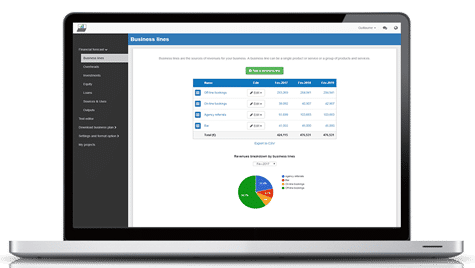How to create a financial forecast for a musical instrument repair shop?
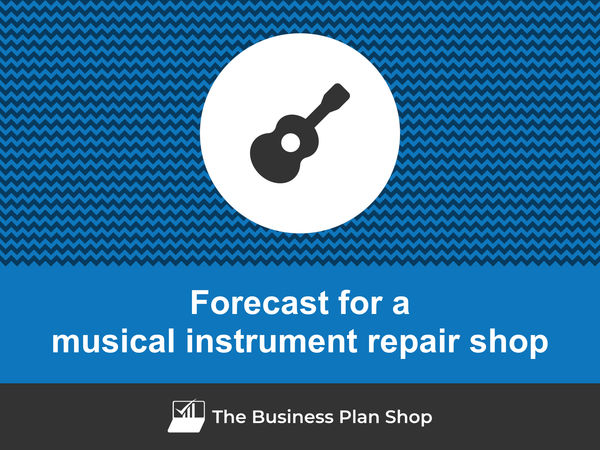
If you are serious about keeping visibility on your future cash flows, then you need to build and maintain a financial forecast for your musical instrument repair shop.
Putting together a musical instrument repair shop financial forecast may sound complex, but don’t worry, with the right tool, it’s easier than it looks, and The Business Plan Shop is here to guide you.
In this practical guide, we'll cover everything you need to know about building financial projections for your musical instrument repair shop.
We will start by looking at why they are key, what information is needed, what a forecast looks like once completed, and what solutions you can use to create yours.
Let's dive in!
Why create and maintain a financial forecast for a musical instrument repair shop?
In order to prosper, your business needs to have visibility on what lies ahead and the right financial resources to grow. This is where having a financial forecast for your musical instrument repair shop becomes handy.
Creating a musical instrument repair shop financial forecast forces you to take stock of where your business stands and where you want it to go.
Once you have clarity on the destination, you will need to draw up a plan to get there and assess what it means in terms of future profitability and cash flows for your musical instrument repair shop.
Having this clear plan in place will give you the confidence needed to move forward with your business’s development.
Having an up-to-date financial forecast for a musical instrument repair shop is also useful if your trading environment worsens, as the forecast enables you to adjust to your new market conditions and anticipate any potential cash shortfall.
Finally, your musical instrument repair shop's financial projections will also help you secure financing, as banks and investors alike will want to see accurate projections before agreeing to finance your business.
Need a solid financial forecast?
The Business Plan Shop does the maths for you. Simply enter your revenues, costs and investments. Click save and our online tool builds a three-way forecast for you instantly.
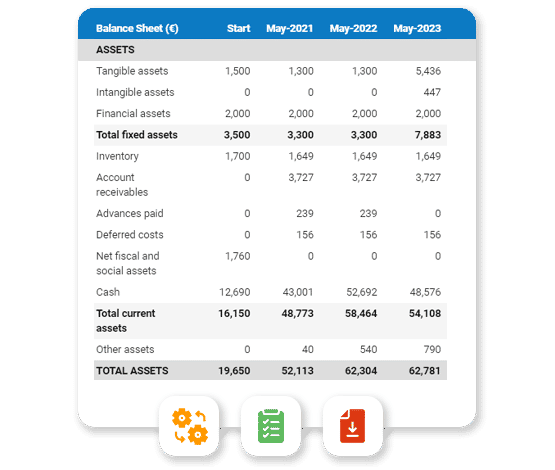
What information is used as input to build a musical instrument repair shop financial forecast?
A musical instrument repair shop's financial forecast is only as good as the inputs used to build it.
If you are creating (or updating) the forecast of an existing musical instrument repair shop, then you mostly need your accounting information, key historical operating non-financial data, and your team’s input on what to expect for the coming years.
If you are building financial projections for a musical instrument repair shop startup, you will need to have done your research and have a clear picture of your competitive environment and go-to-market strategy so that you can forecast sales accurately.
For a new venture, you will also need a precise list of the resources needed to keep the musical instrument repair shop running on a day-to-day basis and a list of the equipment and expenditures required to start the business (more on that later).
Let's now take a closer look at the elements that make up your musical instrument repair shop's financial forecast.
The sales forecast for a musical instrument repair shop
The sales forecast, also called topline projection, is normally where you will start when building your musical instrument repair shop financial forecast.
Creating a coherent sales projection boils down to estimating two key drivers:
- The average price
- The number of monthly transactions
To do this, you will need to rely on historical data (for an existing business), market research data (for both new and existing musical instrument repair shops), and consider the elements below:
- The popularity of certain instruments: As a musical instrument repair shop owner, you know that different instruments require different levels of maintenance and repair. If there is a surge in popularity for a specific instrument, there may be a corresponding increase in demand for repair services, leading to a potential increase in your average price per transaction.
- The state of the economy: Economic downturns can have a significant impact on the disposable income of individuals, affecting their ability to spend on non-essential services such as instrument repairs. In times of economic uncertainty, you may see a decrease in the number of monthly transactions as customers prioritize essential expenses over repairs.
- Competition in the local market: The presence of other musical instrument repair shops in your area can impact your business's average price and number of monthly transactions. If there are a limited number of repair shops in your area, you may have the opportunity to charge higher prices. However, if there is high competition, you may need to adjust your prices to remain competitive and attract more customers.
- The age and condition of instruments: Older and well-used instruments may require more frequent repairs compared to newer ones. Therefore, the age and condition of instruments that your customers bring in for repairs can affect your average price per transaction. Additionally, if there is a trend towards buying cheaper, lower-quality instruments, you may see an increase in the number of monthly transactions as these instruments may require more frequent repairs.
- The availability of alternative repair options: With the rise of online tutorials and DIY repair kits, some customers may choose to attempt repairs themselves rather than bringing their instruments to a professional repair shop. This can potentially lead to a decrease in the number of monthly transactions and a decrease in your average price per transaction as customers may only seek professional help for more complex repairs.
After the sales forecast comes the operating expenses budget, which we will now look into in more detail.
Need inspiration for your business plan?
The Business Plan Shop has dozens of business plan templates that you can use to get a clear idea of what a complete business plan looks like.

The operating expenses for a musical instrument repair shop
Once you know what level of sales you can expect, you can start budgeting the expenses required to operate your musical instrument repair shop on a daily basis.
Expenses normally vary based on how much revenue you anticipate (which is why, from experience, it is always better to start your forecast with the topline projection), and where your business is based.
Operating expenses for a musical instrument repair shop will include some of the following items:
- Staff costs, including wages, benefits, and training expenses for repair technicians, sales staff, and administrative personnel.
- Accountancy fees for bookkeeping, tax preparation, and financial reporting.
- Insurance costs for liability, property, and worker's compensation coverage.
- Software licenses for accounting, inventory management, and customer relationship management systems.
- Banking fees for merchant services, business checking accounts, and credit card processing.
- Rent or lease payments for a storefront or workshop space.
- Utilities such as electricity, water, and internet service.
- Inventory costs for purchasing replacement parts, strings, and accessories.
- Marketing expenses, including advertising, website maintenance, and social media management.
- Repair supplies such as adhesives, oils, and cleaning products.
- Shipping and handling fees for receiving and sending out instruments.
- Professional association dues for industry organizations.
- Continuing education expenses for attending workshops, conferences, and training programs.
- Equipment maintenance and repair costs for tools and machinery used in instrument repair.
- Travel expenses for attending trade shows or visiting instrument manufacturers.
This list will need to be tailored to the specificities of your musical instrument repair shop, but should offer a good starting point for your budget.
What investments are needed to start or grow a musical instrument repair shop?
Once you have an idea of how much sales you could achieve and what it will cost to run your musical instrument repair shop, it is time to look into the equipment required to launch or expand the activity.
For a musical instrument repair shop, capital expenditures and initial working capital items could include:
- Musical Instruments: This includes all the necessary instruments and equipment needed for repair, such as guitars, violins, drums, etc. These instruments can be expensive and may require frequent updates or replacements.
- Repair Tools and Supplies: A repair shop needs a variety of tools and supplies to properly fix musical instruments. This can include items like screwdrivers, pliers, sandpaper, glue, etc. These items need to be purchased regularly to ensure the shop is fully stocked.
- Workshop Equipment: Depending on the size of the repair shop, it may require certain equipment to assist in repairing instruments. This can include items like workbenches, clamps, vises, etc. These items are considered fixed assets and may require occasional maintenance or replacement.
- Computer and Software: In today's digital age, a musical instrument repair shop may need a computer and software for tasks such as inventory management, bookkeeping, and customer database management. These items are considered necessary for the smooth functioning of the business.
- Furniture and Fixtures: A repair shop may need furniture and fixtures such as chairs, desks, storage cabinets, etc. for the comfort and convenience of customers and employees. These items are considered fixed assets and may require occasional updates or replacements.
Again, this list will need to be adjusted according to the specificities of your musical instrument repair shop.
Need a convincing business plan?
The Business Plan Shop makes it easy to create a financial forecast to assess the potential profitability of your projects, and write a business plan that’ll wow investors.
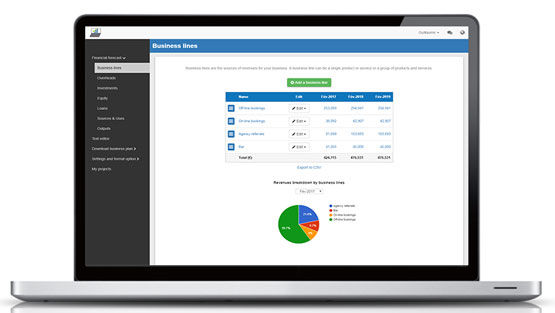
The financing plan of your musical instrument repair shop
The next step in the creation of your financial forecast for your musical instrument repair shop is to think about how you might finance your business.
You will have to assess how much capital will come from shareholders (equity) and how much can be secured through banks.
Bank loans will have to be modelled so that you can separate the interest expenses from the repayments of principal, and include all this data in your forecast.
Issuing share capital and obtaining a bank loan are two of the most common ways that entrepreneurs finance their businesses.
What tables compose the financial plan for a musical instrument repair shop?
Now let's have a look at the main output tables of your musical instrument repair shop's financial forecast.
The projected profit & loss statement
The projected profit & loss shows how profitable your musical instrument repair shop is likely to be in the years to come.

For your musical instrument repair shop to be financially viable, your projected P&L should ideally show:
- Sales growing above inflation (the higher the better)
- Profit margins which are stable or expanding (the higher the better)
- A net profit at the end of each financial year (the higher the better)
This is for established musical instrument repair shops, there is some leniency for startups which will have numbers that will look a bit different than existing businesses.
The projected balance sheet
Your musical instrument repair shop's projected balance sheet provides a snapshot of your business’s financial position at year-end.
It is composed of three types of elements: assets, liabilities and equity:
- Assets: represent what the business possesses including cash, equipment, and accounts receivable (money owed by clients).
- Liabilities: represent funds advanced to the business by lenders and other creditors. They include accounts payable (money owed to suppliers), taxes payable and loans from banks and financial institutions.
- Equity: is the combination of what has been invested by the business owners and the cumulative profits and losses generated by the business to date (which are called retained earnings). Equity is a proxy for the value of the owner's stake in the business.
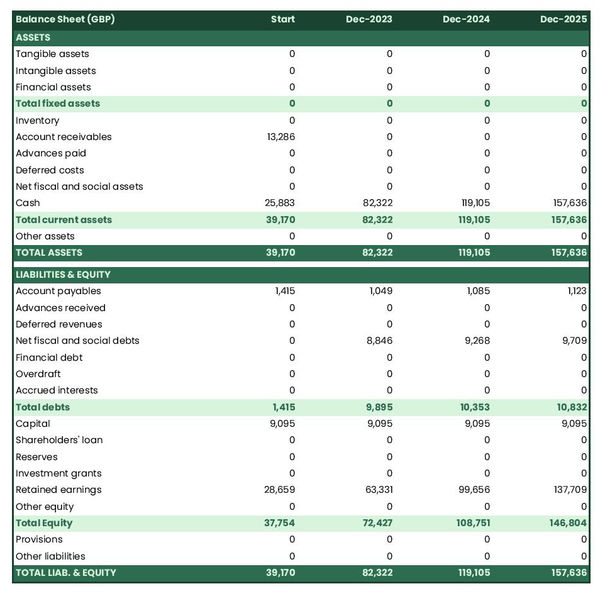
The cash flow forecast
Your musical instrument repair shop's cash flow forecast shows how much cash your business is expected to consume or generate in the years to come.

It is best practice to organise the cash flow forecast by nature to better explain where cash is used or generated by the musical instrument repair shop:
- Operating cash flow: shows how much cash is generated by the operating activities
- Investing cash flow: shows how much will be invested in capital expenditure to maintain or expand the business
- Financing cash flow: shows if the business is raising new capital or repaying financiers (debt repayment, dividends)
Keeping an eye on (and regularly updating) your musical instrument repair shop's cash flow forecast is key to ensuring that your business has sufficient liquidity to operate normally and to detect financing requirements as early as possible.
If you are trying to raise capital, you will normally be asked to provide a monthly cash flow forecast in your musical instrument repair shop's financial plan - so that banks or investors can assess seasonal variation and ensure your business is appropriately capitalised.
Need a solid financial forecast?
The Business Plan Shop does the maths for you. Simply enter your revenues, costs and investments. Click save and our online tool builds a three-way forecast for you instantly.

Which tool should you use to create your musical instrument repair shop's financial forecast?
Using the right tool or solution will make the creation of your musical instrument repair shop's financial forecast much easier than it sounds. Let’s explore the main options.
Using online financial forecasting software to build your musical instrument repair shop's projections
The modern and easiest way is to use professional online financial forecasting software such as the one we offer at The Business Plan Shop.
There are several advantages to using specialised software:
- You can easily create your financial forecast by letting the software take care of the financial calculations for you without errors
- You have access to complete financial forecast templates
- You get a complete financial forecast ready to be sent to your bank or investors
- You can easily track your actual financial performance against your financial forecast, and recalibrate your forecast as the year goes by
- You can create scenarios to stress test your forecast's main assumptions
- You can easily update your forecast as time goes by to maintain visibility on future cash flows
- You have a friendly support team on standby to assist you when you are stuck
- It’s cost-efficient and much cheaper than using an accountant or consultant (see below)
If you are interested in this type of solution, you can try our forecasting software for free by signing up here.
Calling in a financial consultant or chartered accountant
Enlisting the help of a consultant or accountant is also a good way to obtain a professional musical instrument repair shop financial forecast.
The downside of this solution is its cost. From experience, obtaining a simple financial forecast over three years (including a balance sheet, income statement, and cash flow statement) is likely to cost a minimum of £700 or $1,000.
The indicative cost above, is for a small business, and a forecast is done as a one-shot exercise. Using a consultant or accountant to track your actuals vs. forecast and to keep your financial projections up to date on a monthly or quarterly basis will cost a lot more.
If you opt for this solution, make sure your accountant has in-depth knowledge of your industry, so that they may challenge your figures and offer insights (as opposed to just taking your assumptions at face value to create the forecast).
Why not use a spreadsheet such as Excel or Google Sheets to build your musical instrument repair shop's financial forecast?
Creating an accurate and error-free musical instrument repair shop financial forecast on Excel (or any spreadsheet) is very technical and requires both a strong grasp of accounting principles and solid skills in financial modelling.
Most entrepreneurs lack the expertise required to create an accurate financial forecast using spreadsheet software like Excel or Google Sheets. As a result, it is unlikely anyone will trust your numbers.
The second reason is that it is inefficient. Building forecasts on spreadsheets was the only option in the 1990s and early 2000s, nowadays technology has advanced and software can do it much faster and much more accurately.
This is why professional forecasters all use software. With the rise of AI, software is also becoming smarter at helping us detect mistakes in our forecasts and helping us analyse the numbers to make better decisions.
Finally, like everything with spreadsheets, tracking actuals vs. forecasts and updating your forecast as the year progresses is manual, tedious, error-prone, and time-consuming. Whereas financial forecasting software like The Business Plan Shop is built for this.
Need a convincing business plan?
The Business Plan Shop makes it easy to create a financial forecast to assess the potential profitability of your projects, and write a business plan that’ll wow investors.

Use our financial projection templates for inspiration
The Business Plan Shop has dozens of financial forecasting templates available.
Our examples contain both the financial forecast, and a written business plan which presents, in detail, the company, the team, the strategy, and the medium-term objectives.
Whether you are just starting out or already have your own musical instrument repair shop, looking at our template is always a good way to get ideas on how to model financial items and what to write when creating a business plan to secure funding.

Takeaways
- Having a financial forecast enables you to visualise the expected growth, profitability, and cash generation for your business over the next three to five years.
- Tracking actuals vs. forecast and keeping your financial projections up-to-date is the only way to get a view on what your musical instrument repair shop future cash flows may look like.
- Using financial forecasting software is the mordern and easy way to create and maintain your forecasts.
This is the end of our guide on how to build the financial forecast for a musical instrument repair shop, we hope you found it useful. Don't hesitate to contact us if you want to share your feedback or have any questions.
Need inspiration for your business plan?
The Business Plan Shop has dozens of business plan templates that you can use to get a clear idea of what a complete business plan looks like.

Also on The Business Plan Shop
Know someone who owns or is thinking of starting a musical instrument repair shop? Share our forecasting guide with them!

